Tiere in fernen Ländern sind ja immer so eine Sache… die Regel, die wir für Indien bekommen hatten lautete: „Nix anfassen. Dann braucht ihr auch keine Tollwut-Impfung.“
Naja, da Tollwut auch so ein ausgesprochen häßlicher Tod ist, haben wir uns mal lieber dran gehalten. (Außer bei Socksy-Cat, die setzte sich einem auf den Schoß, da war Streicheln dann nicht zu vermeiden. :o) ) Aber auch ohne Anfassen bekommt man in Indien jede Menge Tiere zu sehen.
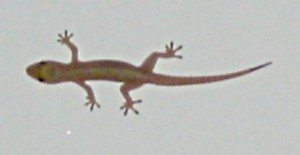 Sie zu photographieren ist dann schon schwieriger, meine Digicam ist damit definitiv überfordert, aber ich plage euch jetzt trotzdem damit. (Wir habe auch eine Spiegelrefelex, aber die ist nicht Digital und die Dias vor den Monitor zu halten bringt nicht viel. *g*)
Sie zu photographieren ist dann schon schwieriger, meine Digicam ist damit definitiv überfordert, aber ich plage euch jetzt trotzdem damit. (Wir habe auch eine Spiegelrefelex, aber die ist nicht Digital und die Dias vor den Monitor zu halten bringt nicht viel. *g*)
The rule we got for contact with animals in India was „Don’t touch, then you wont need a vaccination against rabies. Okay, rabies is a very ugly kind of death, so we decided to do as we were told. (With the exception of Socksy-Cat, who jumps on you lap quicker than you could run away. 😮 ) But you don’t have to touch, we did see a lot of animals, we would normally only get to see behind bars or glass in a zoo.
Taking pictures of them with the Digicam was not the big success, but I’ll be getting on your nerves by showing them anyhow. 😮 (We have one, no several better apparatus, but none of them is numeric…)
Das erste Tier, das uns über einige Tage begleitete war ein Gecko. Er lebte offensichtlich in unserem Hotelzimmer in Kochi, oder in dessen Badezimmer. Und schien auch einige Verstecke zu kennen, denn manchmal war er weg und am nächsten Tag auf einmal wieder da. Wenn er dann genau über dem Bett an der Decke klebt, kann man nur hoffen, daß er weiß, wie er sich festhält.
Our first animal company was a Gecko. He keptus company while we stayed in the hotel in Kochi. It also must have known some very well hinding places in the room or the bathromm, because sometimes it would vanish, to reappear the next day. When this cute animal is walking on the ceiling directely over the bed you can only hope, that it really knows, how to walk there without falling…
 Worauf die Menschen in Kerala besonders stolz sind, sind „Kingfisher“ (Eisvögel). Es gibt übrigens auch eine Biersorte und eine Fluglinie, die nach dem bunten Vogel benannt sind.
Worauf die Menschen in Kerala besonders stolz sind, sind „Kingfisher“ (Eisvögel). Es gibt übrigens auch eine Biersorte und eine Fluglinie, die nach dem bunten Vogel benannt sind.
Bei einer Bootstour in den Backwaters wurde der Führer nicht müde, auf jeden Vogel hinzuweisen. Dummerweise ist die Fluchtdistanz dieser Tiere genau etwas länger als der optimale „Photopunkt“, so daß wir eine große Bildersammlung von „Plätzen wo vor 1/10 Sekunden noch ein Kingfisher gesessen hat“ mitgebracht haben.
Immerhin habe ich einen unscharf verwackelten erwischt. (So ein Boot schwankt ja auch…)
What people in Kerala are very proud of are the Kingfishers. There’s even a beer (not the worst one) and an airline that are named after that colourfull bird.
On a boat-tour on the backwaters our guide pointed out all the birds he could spot. Only the „escape distance“ is just a tad shorter than the distance you would like to take a picture from… so a backwater tour results in a big collection of photos of „spots where 1/10 seconds before a kingfisher would have been“.
Finally I caught a blurry one… being on a boat doesn’t make it easier for my simple, old camera…
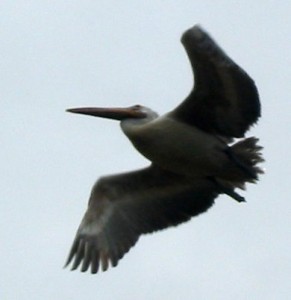 Wesentlich weniger grazös bewegen sich diese Vögel. Sieht man ihnen beim Fliegen zu, fragt man sich manchmal, wie es ihnen überhaupt gelingt, in der Luft zu bleiben… Aber sie sind eindrucksvoll groß!
Wesentlich weniger grazös bewegen sich diese Vögel. Sieht man ihnen beim Fliegen zu, fragt man sich manchmal, wie es ihnen überhaupt gelingt, in der Luft zu bleiben… Aber sie sind eindrucksvoll groß!
Natürlich kenne ich die Tiere aus Zoos, aber ohne Gitter und Käfige ist es doch ein ganz anderes Erlebnis. Und fliegende Pelikane habe ich auch im Tierpark noch nie gesehen.
Im Dorf Kokkarebellur gibt es eine ganze Pelikankolonie. Die Bäume sind voll von ihnen.
The flight of those birds is a less gracefull one. Seeing them fly I wondered, how they manage to stay in the air anyhow… but they are big and impressing.
Of course I’ve been to zoos in my life, but flying pelicans I’ve never seen before.
And the village Kokkarebellur is full of pelicans, the trees are full with pelican nests.
Libellen habe ich natürlich schon gesehen… auch große, etwa in Südfrankreich.
Trotzdem… diese hier waren noch größer.
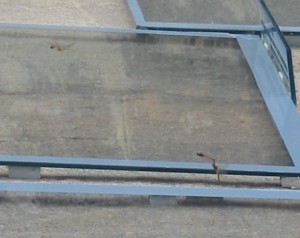 Größer macht jedoch nicht unbedingt klüger… sie waren zu mehreren Paaren mit dem Versuch der Eiablage beschäftigt.
Größer macht jedoch nicht unbedingt klüger… sie waren zu mehreren Paaren mit dem Versuch der Eiablage beschäftigt.
So eine spiegelnde Oberfläche kann ja nur eine Wasserfläche sein, nicht wahr?
Tja… Glasplatten auf dem Boden sind aber auch unfair. :o) Aber es macht komische Geräusche, jedesmal wenn sie die Oberfläche berührten.
No, that were not the first dragonlys of my life. I’ve even seen quite big ones in the south of France. Still… those were even bigger.
Still… bigger doesn’t mean brighter. There were several couples of dragonflys trying to lay their eggs. On the water.
Something shimmering like that can only be water, can’t it?
Okay, glass on the floor is unfair… but it makes funny sounds, when they touch the surface.
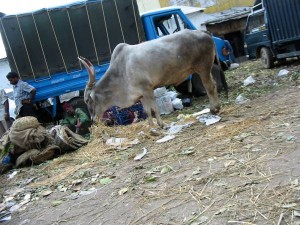 Ja doch, wir haben natürlich auch Kühe gesehen. Sie sind in der Tat allgegenwärtig.
Ja doch, wir haben natürlich auch Kühe gesehen. Sie sind in der Tat allgegenwärtig.
Wobei der Verkehr in Bangalore inzwischen Ausmaße angenommen hat, bei denen auch heilige Kühe keine Lust mehr haben, sich auf die Hauptverkehrsstraßen zu wagen.
Es sind auch keineswegs alle Kühe ohne Besitzer. Zwar werden Kühe von Hindus nicht gegessen, aber vor einen Karren spannen darf man sie wohl. Auch melken darf man sie, denn Milch ist ein sehr wichtiger Bestandteil der indischen Küche.
Erstaunlicherweise sind die Kühe, die mit Menschen unterwegs sind, oft sehr mager und sehen nicht unbedingt gut gehalten aus.
Wohingegen diese Kuh auf dem Markt von Bangalore offensichtlich ein angenehmes Habitat gefunden hat.
Ach ja… Wasserbüffel sind keine Kühe, die dürfen auch geschlachtet werden… (Und es gibt an manchen Orten auch Rindfleisch zu kaufen, nicht alle Inder sind Hindu.)
Surely, we saw cows. Quite a lot of them, of course. They are nearly anywhere.
Except on the main traffic axes of Bangalore, the traffic there evidently is so bad, that even the holy cows prefere to go elsewhere.
A lot of cows also seem to have onwners and the have to work, too, like pulling a cart. A Hindu would not eat the cow, but milk is an important ingredient in Indian kitchen. (And makes very delicous sweets…)
A lot of the cows I saw who seemed to belong to somebody didn’t look to well fed and were quite bony.
On the other hand Bangalore City Market is a good place for cows.
Important to know: buffalos are something completely different from cows! (For me they were always a kind of „relative“ of cows.) Buffalos are allowed to be eaten… (And you can even buy beef at some places in India, not everybody is Hindu.)
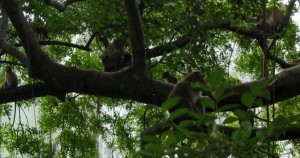 Kleines Suchbild gefällig? Wie viele Affen sind auf diesem Bild?
Kleines Suchbild gefällig? Wie viele Affen sind auf diesem Bild?
Affen im Zoo oder im Zirkus sind süß, wenn man mit ihnen leben muß sind sie hingegen eine Plage.
Schließlich sind sie intelligent und wissen, wo die Küche ist… zwar sind die Öffnungen in der Regel vergittert, wenn Affen in der Region zu erwarten sind, aber dennoch sollte man auch im 4. Stock alle Dinge mindestens eine affenarmlänge vom Fenster wegstellen.
Und wenn so eine Horde Affen durch die Wohnung getobt sein sollte, dann ist einmal neu Einrichten angesagt. Da bleibt nichts mehr intakt.
A little puzzle? How many monkeys are there in the picture?
Monkeys in the zoo or in a circus are cute. But those who have to live with them prefere to call them „Plague“….
They are intelligent and they know, which is the kitchen window. Even if you life on 4th floor you should put nothing closer than one monkey-arm-length to the kitchen window. Sometimes you find grills on the windows. Which gives a very strange feeling, because the normal experience with monkeys is, that they are inside the cage and you outside. But in India you might find yourself on the other side of the grill.
But if a family of monkeys or only one of them gets in your house, then you need the complete set of new furniture…
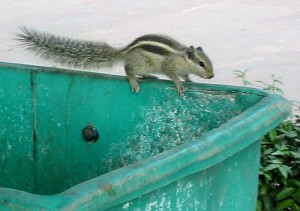 Woran ich mich wegen des hohen „Süßfaktors“ auch kaum sattsehen konnte, waren die Streifenhörnchen in Delhi.
Woran ich mich wegen des hohen „Süßfaktors“ auch kaum sattsehen konnte, waren die Streifenhörnchen in Delhi.
Im Gras oder an Bäumen sieht man sie oft erst, wenn sie sich bewegen. Beeindruckend, wenn ein Spaziergänger sich nähert und auf einmal zig brauche Erdflecken und welke Blätter auf dem Boden lebendig werden und in Windeseile einen Baum hinaufspringen.
Aber natürlich wissen auch diese possierlichen Tierchen die Folgen der Zivilisation zu schätzen. Und um die freien Plätze im „Restaurant Papierkorb“ wird heftig gekämpft.
(Noch erstaunlicher wie flink die Streifenhörnchen trotz der glatten Wände hineinkommen ist allerdings, wie schnell sie auch wieder herauskommen können…)
Definitely an extremely high „cuteness“-factor have the squirrels in Delhi.
Sitting on the lawn or on a tree they are hardly visible. Until they move. And it’s quite spectacular when you walk and suddenly in front of you brown spots of soil between the grass and fallen leaves become very alive and run and jump up the next tree…
Of course they also like civilisation. Free places in the „Restaurant Chez Garbage Can“ are something to fight for.
(And what is more surprising than how quickly the squirrels can climb tha plastic walls of a dustbin to get in, is that they can climb even faster to get out…)
